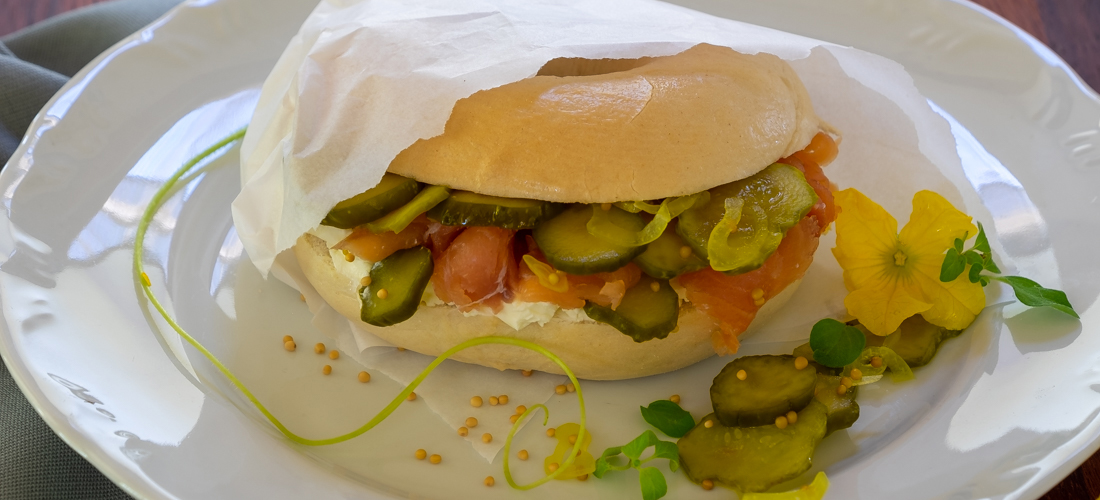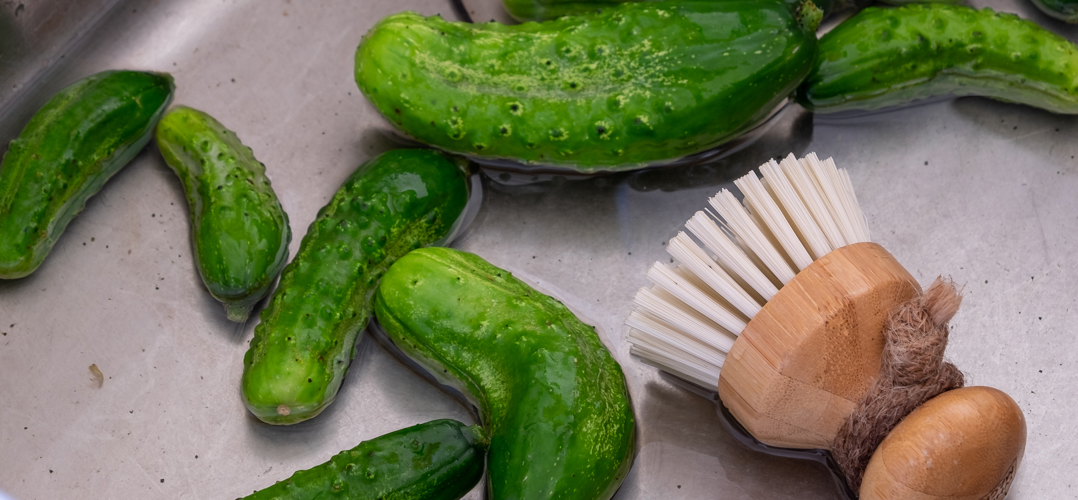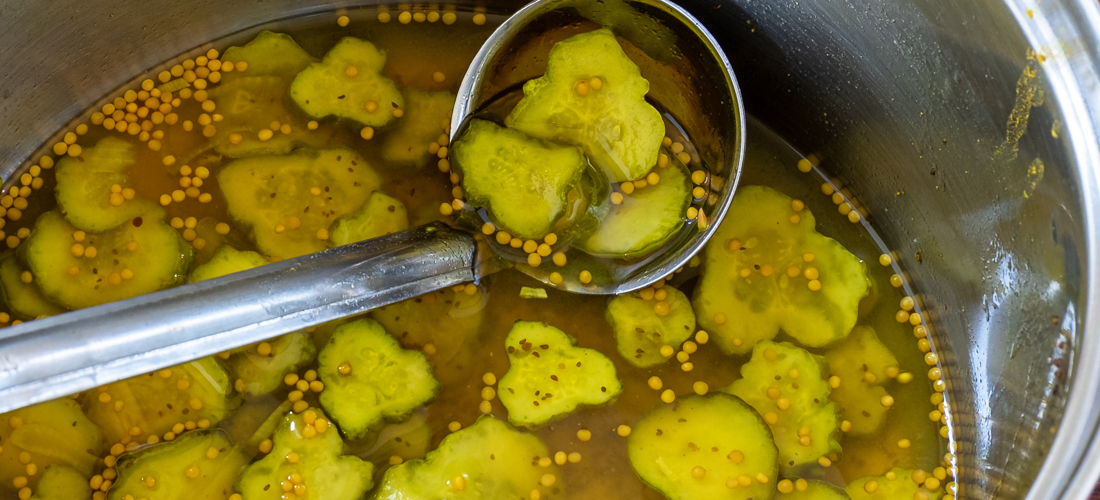Bread & Butter Pickles
- Pickles, Chutney, Relish & Sauces

Bread and butter pickles, affectionally called B&B’s in our household, are an indispensable pantry staple. This simple recipe is a great way to learn how to pickle and will quickly transform an abundant harvest or a seasonal buy at the market into a versatile “go to” accompaniment. Sass up your next ploughman’s plank or anti pasta platter, smoked and fresh seafood dishes, cured meats, and of course the burger. As a filler it will take your favourite sandwich, roll or bagel to the next leave or just put it on the table at your next family gathering or BBQ and watch it disappear.
Typically, pickling cucumbers, often referred to as picklers, are a special variety intended for pickling. They grow to 7-10cm long and 2.5cm wide and are shorter, thicker and not as regularly-shaped as slicing and burpless varieties. Their bumpy skin, which reminds me of a lunar landscape, has either tiny white or black spines that need to be removed with gentle scrubbing before salting.
- Preparation Time:
- 60 minutes plus 3-4 hours salting
- Cooking Time:
- 10 minutes
- Quantity:
- 2-3 x 750 ml jars
PREPARATION
Sterilise sealable good quality glass jars with sealable lids

INGREDIENTS
- 900g
- Pickling cucumbers, 10 cm long
- 2
- Brown onions, small
- 36g
- Sea salt or preserving salt
- 1 litre
- Apple cider vinegar
- 250 ml
- Water
- 215g
- Sugar, white
- 1½ teaspoon
- Brown mustard seeds, whole
- 1 teaspoon
- Dill seeds, whole
- 1 teaspoon
- Fennel seeds. whole
- ¼ teaspoon
- Turmeric powder
- 1 teaspoon
- Chilli flakes, options

METHOD
Start with removing the spiky hairs from the picklers, then salting for 3-4 hours to remove any excess moisture then a quick simmer in flavoured vinegar and your B&B's are almost finished. Vacuum seal the potted pickle using either the Food Preserving Unit or the Stock Pot Method and you'll have a fine batch of traditional bread and butter pickles with an extended shelf life.
If the cucumber flower is still attached remove and gently wash the cucumbers thoroughly to remove any garden debris and the spiky hairs on the skin. Dry lightly with paper towel or a clean dry tea towel. Slice the cucumber into 4 mm thick rounds, discarding the ends.
Peel the onions and slice into 2 mm rounds.
Place sliced cucumbers and onion in a glass or stainless-steel bowl and sprinkle with salt. Empty 2 trays of ice cubes on them and stand covered with a clean tea towel, at room temperature, for 3-4 hours.
Drain the vegetables through a colander and allow to drain for approximately 5 minutes to remove excess moisture.
In a large stainless-steel pot, combine the vinegar, sugar, turmeric, fennel seeds, brown mustard seeds. Bring to the boil, turn to simmer, and stir until the sugar is dissolved.
Add the drained cucumber and onions and bring back to the boil quickly and then simmer for 5 minutes, until they are just cooked, but still crunchy.
Using a pair of tongs transfer the cooked cucumber mixture to the dry sterilised jars. Do not over fill the jars at this point. Add the peppercorns to each jar.
Use a funnel to cover the pickle with the vinegar solution and fill to approximately 2.5cm (1 inch) from the top of the bottle and seal. The vinegar must completely cover the pickles.
Seal the jar and process in a hot water bath using either a Food Preserving Unit or the Home Stock Pot Method for 30 minutes. This will heat seal the jars and lengthen the shelf life as the vacuum seal will prevent contamination during storage.
Food Preserving Unit Method
Place sealed jars in Fowlers Preserving Unit (link) or equivalent.
Cover with water, bring to the boil and hold at gentle boil for 30 minutes.
Turn off, remove lid, and allow to stand for 5 minutes before removing.
Using the tap draw off some of the hot water so the level is sufficiently below the bottles to be able to safely remove them without scalding yourself.
Remove from hot water bath and place on a board to rest overnight. A vacuum will form inside each jar and as it cools, it will draw down the lid and create a secure seal.
Stock Pot Method
Line a large stock pot with some sheets of newspaper or a cut-down cake rack. Place the bottles on the newspaper or rack, in the pot, allowing space between each bottle so they do not touch. This lining will protect the bottles from direct heat and help prevent cracking.
Cover the preserves with water which is the same temperature as the preserves. Bring to the boil and hold at gentle boil for 30 minutes.
Turn off, remove lid, and allow to stand for 5 minutes before removing. If possible, remove some of the hot water so the level is sufficiently below the bottles to be able to safely remove them without scalding yourself.
Remove from hot water bath and place on a board to rest overnight. A vacuum will form inside each jar and as it cools, it will draw down the lid and create a secure seal.
-
Label and store in a cool dark place in the kitchen or pantry.
Allow the pickles to mature for at least 4 weeks before eating.
After opening store in the refrigerator.
NOTES
- Smaller and slightly larger sized cucumbers can be used. Larger cucumbers may have to be cut in half first before slicing into rounds. Adjust according to the size of the cucumbers and jars.
- Salting the cucumbers and onion will draw out any excess moisture and makes a crisper pickle.
- Good quality jars should be used in all preserving, particularly when they are processed in a hot water bath. Thin jar often cannot withstand the temperatures and may crack either in the bath or on and/or after removal. Avoid the disappointment and invest in some good jars from a homewares or preserves outlet. Select jars with non-reactive lids as the vinegar solution can cause lids to rust over time.
- Use good quality sea salt, often referred to as pickling salt, not table salt, when making pickles and preserves. Table salt contains stabilisers and anti-caking agents and often iodide which form a whitish haze and sediment. These additives and in particular iodine can affect the appearance and taste of pickles and during the maturation and storage period. The ingestion of a cocktail of anti-caking chemicals such as calcium silicate, sodium silicoaluminate, tricalcium phosphate, magnesium carbonate, silicon dioxide and yellow prussate of soda, is also unnecessary.
- Caution: Use of reduced-sodium salt in fermented pickle recipes is not recommended. The lower salt percentage creates a favourable environment for the growth of undesirable bacteria while retarding in the growth of desirable bacteria. The correct concentration of salt is vital to texture and food safety.
- Good quality jars should be used in all preserving, particularly when they are processed in a hot water bath. Thin jars often cannot withstand the temperatures and may crack either in the bath or on and or after removal. Avoid the disappointment and invest in some good jars from a homewares or preserves outlet. Select jars that have non-reactive lids as the vinegar solution can cause the lids to rust over time.
- Processing the pickles in the hot water bath is an important step as it will kill bacteria in the pickle mix as well as lengthening the shelf life. This low temperature pasteurisation method helps to keep the pickles crisp while higher temperatures processing tends to soften the vegetables.
- Variations. Jazz up you B&B’s to suit your taste by adding whole chillies, garlic, bay leaves, celery seed or for a more floral flavour, lemon zest or coriander seeds.
